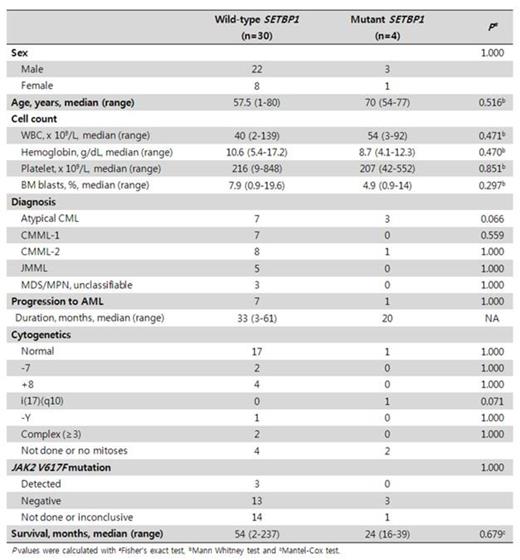Abstract
Recently, recurrent somatic SET-binding protein 1 (SETBP1) mutations were found in atypical chronic myeloid leukemia (aCML) and other related myeloid neoplasms. According to reports so far, SETBP1 mutations occur in 9% of myelodysplastic/myeloproliferative neoplasms (MDS/MPN), especially in high frequency (24∼30%) of aCML. SETBP1 mutations were associated with worse prognosis and higher white blood cell (WBC) counts. Most of the reports came from western countries and there was a need to further study its clinicopathological impacts in East Asian patients because of paucity of reports. Therefore, this study investigated the prevalence and clinical implications of SETBP1 mutations in MDS/MPN patients at a single medical center in South Korea.
We analyzed a cohort of 34 MDS/MPN patients (10 aCML, 7 CMML-1, 9 CMML-2, 5 JMML, 3 MDS/MPN unclassifiable) who were diagnosed and treated in Chonnam National University Hwasun Hospital (Hwasun, Korea) from October 2004 to June 2013. The mononuclear cells from bone marrow of the patients were separated and the total DNA was extracted by commercial kit (QIAGEN, Hilden, Germany). PCR and sequencing reaction were performed by targeting the hot spot (exon 4, codon 778-979) of the SETBP1 gene. The PCR mixture consisted of 50 to 100 ng of total DNA, 20 pmol of each forward (5'-CCACTTTCAACACAGTTAGGTG-3') and reverse (5'-TCTCGTGGTAGAAGGTGTAACTC-3') primer, 0.4 mM of each dNTP, 5 μL 10X F-taq reaction buffer, 5 U of DNA Polymerase (Solgent, Daejeon, Korea) and H2O in a final reaction volume of 50 μL. Direct sequencing was performed using the ABI Prism 3130XL Genetic Analyzer with the BigDye Terminator v3.1 Ready Reaction Kit (Applied Biosystems). Clinical information about patients was obtained from our electronic medical record database. All statistical computations were performed using PASW 18.0 (SPSS Inc., Chicago, Illinois, USA).
In this analysis, 4 (11.7%) of 34 MDS/MPN patients showed SETBP1 mutations. 3 of them were aCML patients and 1 was CMML-2 patient. The frequencies in aCML and CMML-2 were 30% and 11.1%, respectively. All of the aCML patients with SETBP1 mutation showed mutation encoding c.2898G>A (p.Asp868Asn) and the CMML-2 patient displayed c.2903C>T synonymous mutation (Ser869).The mutated SETBP1 patients showed a tendency of higher mean WBC counts, lower mean hemoglobin, lower mean platelet counts and lower mean BM blasts percentage than the wild-type patients, but they were not statistically significant. One of the mutated SETBP1 patients showed a i(17)(q10) cytogenetic abnormality. We found no statistical difference in overall survival (OS) between mutated SETBP1 patients and wild-type patients.
Alteration of SETBP1 gene was a common genetic event in aCML with an impact as a diagnostic marker for MDS/MPN.
No relevant conflicts of interest to declare.
Author notes
Asterisk with author names denotes non-ASH members.


